On the Beach:
Between Product and Process
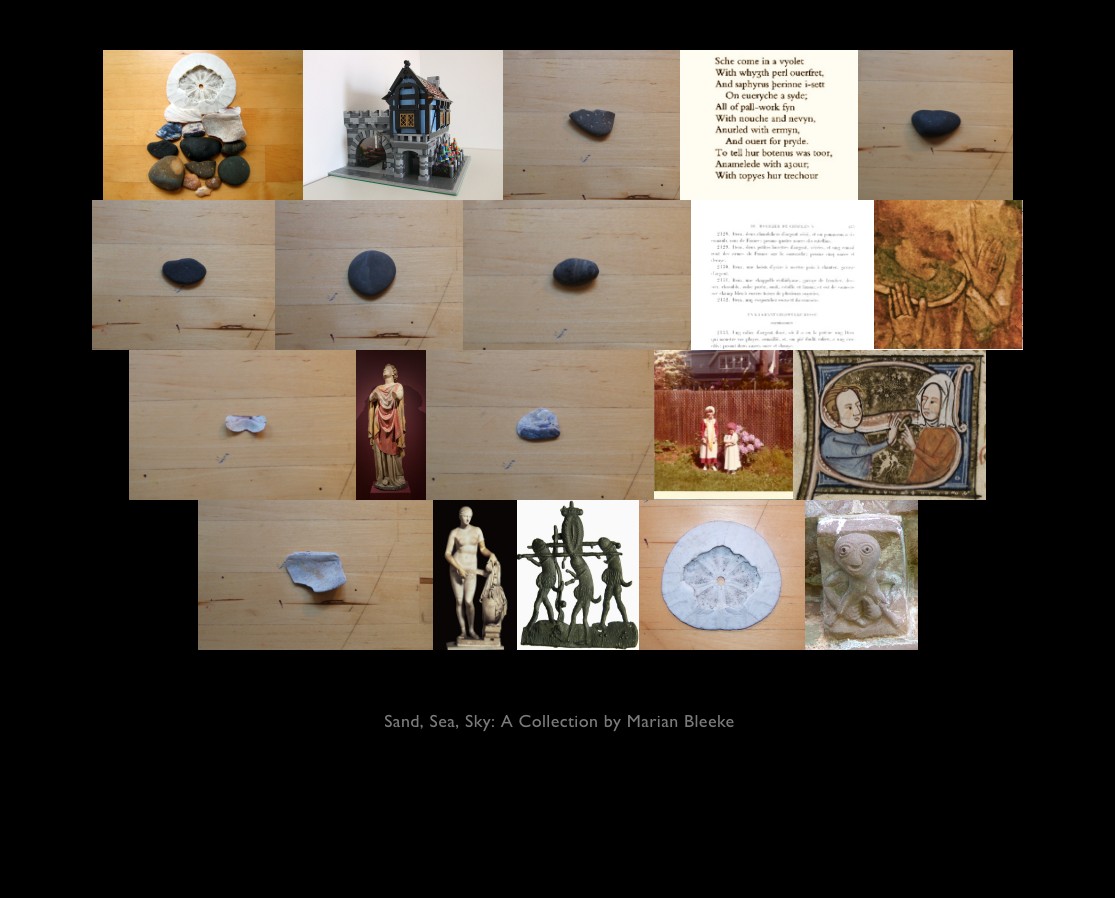
1. Sand, Sea, Sky
In creating my exhibit for the Beachcombing session for Babel 2014, I decided to take the metaphor of beachcombing as seriously as possible, and this meant working rather intuitively. In my experience of actual beachcombing, I typically collect things without a clear intention or motivation or outcome in mind; instead, I pick up whatever appeals to me, for whatever reason, and without much reflection on those reasons. To follow that model as closely as possible for this project, I picked one item from Lara’s “shore” collection each day, for six consecutive days, picking whatever happened to appeal to me on that particular day, and creating a page for it in my exhibit.
However, for this project I did take the next step of reflecting in writing on why I picked each item and so on the particular appeal it holds for me: this writing forms the first paragraph of text on each page in the exhibit. And the title of each page names its item’s specific appeal: Making, Difficulty, In/Complete, Wearing/Being, Intimacy, and Energy. Making and Wearing/Being both relate to experiences from my childhood, connecting a photograph of a toy castle to the world I constructed in my bedroom, and a photograph of a woman in medieval garb to one of myself and a friend both in full Little House on the Prairie garb. Difficulty and In/Complete both spring from my encounters with the items themselves, my struggle to read a bit of text and both my desire and my resistance to imaginatively completing a damaged fresco. Finally, Intimacy and Energy both originate in my interpretations of the items and so call on my skills as an art historian. 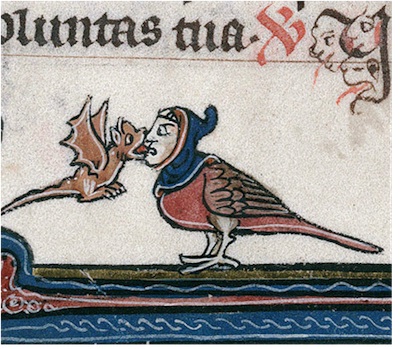 sweet kiss
sweet kiss
Breviary, France 13th century. Cambrai, Bibliothèque municipale, ms. 102, fol. 195v.
I read an image of an exchange of rings as representing romantic love, but also as suggesting a violence inherent to that set of ideas, and I read a phallic pilgrimage badge as both representing a sexualized energy and attributing that energy to the body of the medieval person who originally wore it. Thus my initial attractions to these items brought together the past and the present along with the personal and the professional.
To further develop my exhibit while remaining as close to the beachcombing metaphor as possible, I next paired each item I had selected with an actual beachcombed object, a stone or shell that I gathered on a family trip to the Oregon coast several years ago. I attempted to match the specific appeal I had identified for each item in the exhibit with a similar quality in a beachcombed object: my reflections on that match form the second paragraph of text on each exhibit page. For Making, I chose a chunk of what looks to be a man-made composite material rather than a natural stone; for Difficulty, a group of black stones that I was finally able to “read” in a very limited way by identifying differences between them; for In/Complete, a fragment of a shell that could also be seen as a whole miniature landscape; for Wearing/Being, a curved shell that wrapped around my finger and warmed up as I held it; for Intimacy, a tiny fragile shell fragment; and for Energy, a sand dollar that had been broken open by a bird. 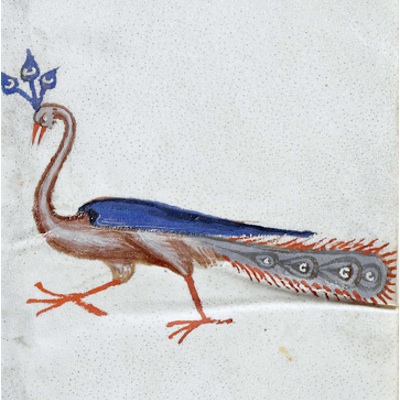 marginal peacock
marginal peacock
Anjou Bible, Naples ca. 1340. Universiteitsbibliotheek Leuven, Cod. 1, fol. 38r.
Next, I pressed the metaphor of beachcombing in the direction Lara had set for us in this project, as a way of thinking about our relationship(s) to the past. I considered how the specific appeal I had identified for each item in the exhibit, the quality I had likewise identified for each stone or shell, might also appear in that relationship: this work forms the third and final paragraph of text on each page of the exhibit. In these paragraphs, I identify the past as a made thing, wonder about the quality of engagement that comes from the difficulty of understanding the past, consider the tension between reconstruction and aesthetic attraction in art historical practice, identify my own life-long desire for temporal otherness, wonder about the violence the past does to us as we draw it close, and consider the potential the past has to surprise us.
Finally, for some reason, when I got back home to Cleveland after that trip to the Oregon coast, I assembled my beachcombed stones and shells into a landscape and photographed it: this image appears on the Introduction page for my exhibit. I decided to also allow it to dictate the structure of the exhibit itself, so that the location of each stone or shell in the landscape determined its page’s place in the exhibit as a whole. And this likewise determined the sections of the exhibit and their order, moving from foreground to background as Sand, Sea, and Sky.
I have to admit that this was a difficult project for me to work on, until I allowed myself to work in the more intuitive way I just described. Prior to this, I put off getting started on the project, and I
had several false starts before I came up with what I have described here. The problem was that I wanted to have a clear idea of what the outcome of my work, the final exhibit, would look like before I started to work on it. But for a long time, I didn’t have an idea, and so I didn’t get started. 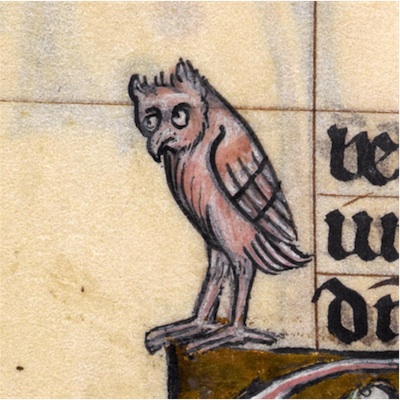 baffled owl
baffled owl
‘The Maastricht Hours’, Liège 14th century. British Library, Stowe 17, fol. 162v. And then I had a couple of different ideas, but I wasn’t satisfied with any of them, and so I got started on a couple of different things, rather half-heartedly, and then gave up on each and deleted what I had done. My hesitations over this project have a lot to do with my long-standing tendencies towards anxiety and depression. The uncertainty of not-knowing the final outcome of something can make me extremely anxious, and that can get in the way of me doing it at all. This is especially true because I tend to jump ahead and imagine possible outcomes for most of the projects I engage in, but I typically imagine negative outcomes, and that further discourages me from doing the work.
The key for me in getting beyond those issues for this project was shifting my attention away from its end product and to the process that I was engaged in, the process that I described above—which is why this description is focused on my process more than the exhibit itself. This is where I found Lara’s metaphor of beachcombing to be particularly helpful, because when I think of beachcombing, it is typically as a process that doesn’t have an end product. On this trip to the Oregon coast, for example, my sister-in-law was also picking things up on the beach, but she left everything that she collected behind in the house we had rented for the weekend, because she didn’t know what she would do with it. 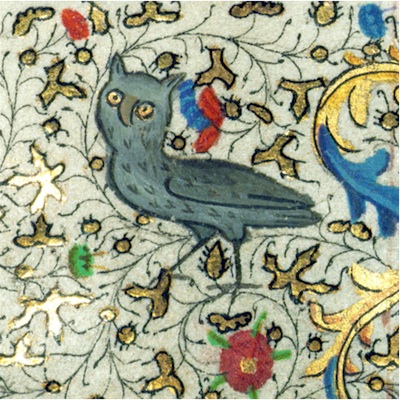 owl
owl
book of hours, Hainaut ca. 1450-60. Baltimore, Walters Art Museum, Ms. W.267, fol. 179v. I brought my shells and stones back to Cleveland with me and made my landscape photograph, but then I put them into the container full of rocks that I use as drainage for potted plants, and so I had to dig them out again to use in this project. The experience of working on the project, finally, prompted me to think more about the relationship between process and product in my own work and in scholarly work in general.
2. Counter-Productivity
In terms of my own work, this thinking about the relationship between process and product took place in the context of a sabbatical year during which I was working on a book project. Spending a year working just on the book was an unexpectedly difficult thing for me to do because I can’t write all day, every day, and yet it seemed like that was exactly what I should be doing. My typical process is to spend between one and three hours in the morning writing, and to write between one paragraph and two pages in that span of time, depending on how much time and space is needed to take the next step in the argument I’m making. If possible, I will write that way every day, up to six days a week, counting on the frequency of writing rather than the length of any one writing session to generate a significant amount of material. This is the practice I developed in graduate school in order to be able to produce my dissertation while teaching part-time; it is the practice I have tried to maintain (with more and less success) while teaching full-time; and it is the practice I immediately revert to in the summer. But during my sabbatical, it left all afternoon writing-free and that made me anxious: surely, I should be writing during that time in order to make sure I finished the book by the end of the year. 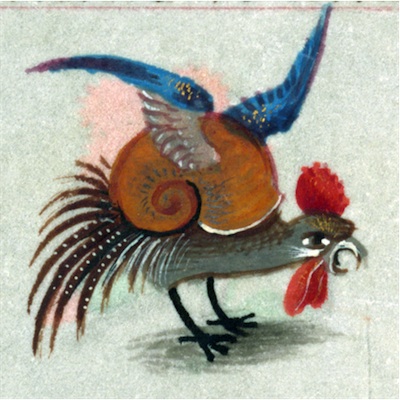 snailcock
snailcock
book of hours, Bruges ca. 1500. Baltimore, Walters Art Museum, Ms. W.427, fol. 171v. And so process appeared to me as opposed to product: I could stick to the practice I knew worked for me, or I could let my anxiety about the end product—about my own productivity—ruin it for me.
This opposition between process and product, or productivity, was enhanced by the type of writing I was doing at the time: re-writing the introduction and two chapters of the book so that I could re-submit the intro and one chapter for re-review by a press in hopes of getting a contract for the book. The amount of re-doing involved made it difficult for me to feel that I was making much progress on the project: I reliably sat down in the mornings to write, but it was hard to see what I had to show for all of that work. And there was no guarantee that there would be anything to show for it all in the end, since the book was not yet under contract. All of this work could have been for nothing. (Update: I now have a contract for the book.)
These personal anxieties were augmented by new workload policies that recently went into effect at my university. When I was hired, the standard teaching load for full-time faculty was two four credit hour courses per semester (sixteen credit hours per year), and faculty were understood to also be active in research (or other creative or professional activity) and in service. 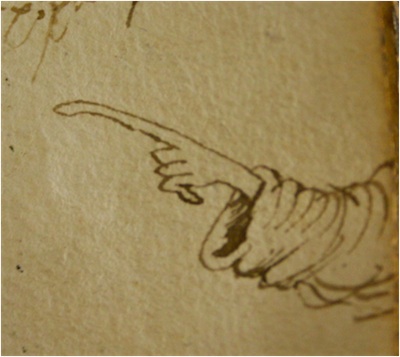 manicula 1
manicula 1
St Andrews, University Library, Typ NL A85 JT (Antwerp, 1487-1490). URI. Some departments had articulated specific expectations for research productivity for faculty going up for tenure, a set number of articles, for example, or a book: my department had not because of the need to accommodate a wide variety of different types of faculty members (artists and designers as well as art historians). And there were no specific research expectations for post-tenure faculty. Throughout my time on the tenure-track, I looked forward to tenure as the moment when I would be able to stop being anxious about my research productivity, would stop counting up my publications on my fingers and toes at odd moments in order to reassure myself, and would be free to work on my research and writing without the pressure of having to produce to meet expectations.
Shortly after I was tenured, however, the situation changed radically. The standard teaching load is now five three credit hour courses per year (fifteen total credit hours), but that load can be increased if a faculty member isn’t meeting expectations for research productivity. And each college has articulated specific expectations for that type of productivity for tenured faculty: in my college, it is two articles in the past three years or a book in the past five (or equivalents for the artists and designers along with the actors, dancers, musicians, etc.). 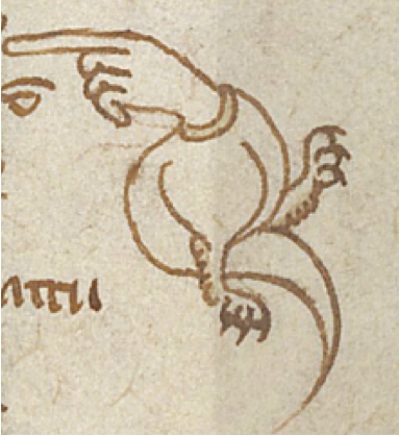 dragon with hand
dragon with hand
British Library, Royal MS 12 E.xxv (c. 1300). URI. According to the administration, faculty who don’t meet these research expectations have “chosen” to focus on teaching and so should have increased teaching loads: like most faculty, however, my reaction was and is that increased teaching is being used as a threat and potentially a punishment for anyone who doesn’t maintain the now-expected level of productivity. So far I have met expectations, but these new policies mean that my work post-tenure is not free from the pressure to produce and that I have not stopped counting my publications in moments of anxiety.
That activity of counting is crucial to understanding these specific policies in terms of the general conditions for contemporary academic work. My university’s policies were clearly formulated to address a board of trustees, a state legislature, and a general public that are increasingly skeptical of higher education and those of us who work within it. “I attempt to provide the terms of an institutional pragmatism that can make an argument for the tactical use of the space of the University….Significantly, this concerns the question of how the University is to be evaluated, and it argues for the need for a philosophical separation of the notions of accountability and accounting.” (Readings, 1996, 18). These bodies demand “accountability” from us and, as Bill Readings explains in The University In Ruins, that is all too easily reduced to mere counting: teaching to enrollment numbers or student credit hour production, and research to numbers of books and articles and their equivalents (1996, 119-34, 150-65). In this way, the complex work of teaching and of scholarship disappears behind the simple fact of the amount done, and so products and productivity are valued above the processes that make them possible. And I am left wishing that I could produce what my university expects of me without having to engage in any sort of process at all—wishing that elves would come in the night and write my book for me or that it could spring full-formed from my mind.
During my sabbatical, I felt the need to respond to these personal anxieties and professional pressures by asserting the value of process. On a personal level, I did so by talking much more openly about my own writing process, with my family in particular, which had always been difficult for me. Professionally, I organized a session (along with Asa Mittman and sponsored by the Material Collective) for the 2015 Babel meeting in Toronto, entitled “Counter-Productivity: Valuing Scholarly Processes,” in which I invited others to join me in reflecting on our own processes as a way of granting them a value independent of their final products. As stated in the call for participants for the session, its guiding questions were: What do you actually do when reading for a research project? When you get to the library, archive, museum, or other site of research and encounter the manuscripts, collections of papers, works of art, or other materials that you have come to see? What do you do when you are thinking? When you sit down to write? And what do you find yourself doing instead when you are meant to be doing any of these things? Finally how and why did you develop your own scholarly practices? Have your practices as a scholar shifted over time and, if so, how and why?
3. To Free Writing
I knew from the start that I was going to be one of the presenter/participants in the “Counter-Productivity” session. I knew what I was going to talk about: my practice of “freewriting,” that is, of using informal writing in a stream-of-consciousness style as a medium for thinking through ideas on my way to writing more formal academic prose. And I knew how I was going to write it: by freewriting about freewriting for a set amount of time, then reading through the accumulated material to identify the main ideas, then writing the presentation itself in a faux-freewriting informal style. Thus, unlike my exhibit for the Beachcombing session, I felt like I had this all figured out in advance and assumed it would be an easy piece for me to produce.
What I hadn’t anticipated was the content that would come up in my freewriting about freewriting, in particular, my negative attitude towards my own writing practice that emerged in this work. Given that I have to write somehow, that my book isn’t just going to magically appear, I still wish that I could at least write differently. I wish that, instead of writing a little bit a day, everyday, I could sit down in a moment of inspiration and have it all spill out of me. And I wish that, instead of using freewriting to write my way into each day’s writing stint, I could sit down and write the actual text in polished academic prose. Suzanne Akbari describes writing the way I wish I could write in her in essay in the collection How We Write (2015, 9-17). “When that time come, when you’re truly in the writing zone, there’s nothing like it – it’s fantastic, so exhilarating, completely satisfying.” (Akbari, 2015, 10) She writes in bursts of inspiration, although she states that writing a little bit at time sounds much more sane and healthy. I write a little bit at a time, but think it is a dull and plodding way to work, whereas writing in bursts of inspiration would be much more romantic and exhilarating. And I secretly believe that, if I were actually any good at writing, I would be able to write in those inspired bursts and have finished prose flow from my fingertips, and the fact that I can’t do that means I’m no good at this part of my job.
Recognizing the level of negativity about my own process that surfaced in my freewriting about freewriting was disturbing to me: this is the only way I know how to write, but on some level I think it’s the wrong way to write, even that it is a sign of my own lack of ability as a writer, and that seems to condemn me to a future of writing plagued by self-doubt and self-loathing. Where does that negativity come from? In general, it comes from school, where the ability to quickly produce polished prose was and is so highly valued. And it comes from romantic representations of artists as inspired geniuses. And for me, personally, it comes from the circumstances in which I developed this specific practice. This was back in graduate school, when I came very close to failing to write my dissertation. I was doing all sorts of other things at the time to distract myself from that fact, because I couldn’t face up to it. Finally though, my life got so messed up that even I had to recognize that things had to change: I cut off certain friends, cut off my long hair, quit my part-time job, rearranged the furniture in my apartment, got into therapy, and bought my first academic self-help book. It had the alluring title of Writing Your Dissertation in 15 Minutes a Day and there were stacks of it next to the register at a bookstore near campus (Bolker, 1998). It made it possible for me to write my dissertation and my current writing process comes almost directly from its pages. 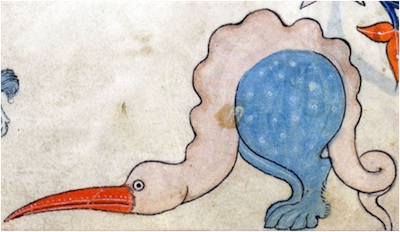 flightless
flightless
Luttrell Psalter, England ca. 1325-1340. But because of its origins in this moment of crisis, that process still feels to me like a last-ditch effort against imminent failure, and so it is freighted with fear and guilt and shame.
Since coming to this realization, I have been trying to figure out what to do about it. If I am going to continue writing, and writing using this process since—again—I don’t know any other way to write, then I need to find a way to “free” the process from these negative associations. For the past several months, I have worked on doing this by creating a different association for my writing, with the knitting, crocheting, and embroidery work that I do in the evenings. I have been doing this kind of textile work, off and on, since I was a child, and doing it more regularly over the past decade or so. It is something I do “freely,” not because I have to do it for my job, but because I enjoy doing it. And I enjoy exactly the doing of it, the process itself, which is more important to me than the end product. For if what I wanted was the product, a sweater or a hat or a blanket or whatever, it would be so much easier, faster, and usually less expensive, to simply buy one already made. Unlike writing, then, where the process cannot be outsourced to others or wished away, this process could be through commerce, but I don’t want it to be because I enjoy it. I am hoping that linking these two processes can bring to the same positive value to my writing.
4. Text, Textile, and the Tactile
I have been building this new association by keeping track of the amount of time I spend writing on any given morning, and the amount of time I spend on textile work that evening, and whether writing in the morning correlates to working on a textile project that evening, and likewise whether working on a project in the evening correlates to writing the next day. When I first started doing this, I thought of it as observational: seeing whether writing led to working on a project and vice-versa. But I soon found that the observation was changing what I was observing—myself, that I wanted to see positive correlations between the two practices and that was leading me to do more of both. Thus ironically, a focus on process allowed me to become more productive.
I do have one hesitation about this joining of my writing and textile practices, however, which has to do with the medium I’ve used to bring them together—time. “We believe that the problems of time stress will not be solved with better work habits…Time management does not take into full account the changes to the university system: rather, it focuses on the individual, often in a punitive manner (my habits need to be pushed into shape). The real time issues are the increasing workloads, the sped-up pace, and the instrumentalism that pervades the corporate university.” (Berk and Seeber, 2016, location 458). For as Maggie Berk and Barbara Seeber make clear in The Slow Professor: Challenging the Culture of Speed in the Academy, there is a strong relationship between the productivity pressures in contemporary academic life and issues of time, in particular an obsession with time management and a persistent sense of the lack of adequate time (Berk and Seeber, 2016). I had thought of using a different medium to join the two processes, my body, by seeing if I could get a Fitbit or similar device to record my movements as I write or knit, crochet, or embroider. However, I was put off by these devices’ implication in notions of accountability in transforming our daily lives and activities into numbers to be recorded and tracked, measured and judged.
This is where Lara’s beachcombing metaphor may again become useful to me, in that she pointed out in her response to an early version of this essay a relationship between textile processes and beachcombing in their shared tactility: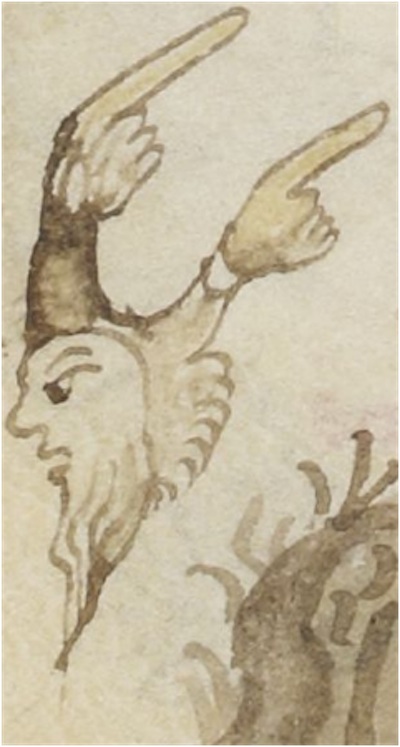 double manicula
double manicula
Paris, BnF, lat. MS 4935 (15th century). URI. both involve touching, handling, and holding, whether yarn or thread and needles or hooks, or shells and stones. And both grow in the hand throughout the process: in beachcombing, I will gradually fill my hands with shells and stones until I just can’t carry any more and then will edit my collection down in order to be able to continue to pick up new things, while one of the deep pleasures of knitting and crocheting lies in feeling the piece getting larger and larger as I work on it. Is there a way of bringing the same satisfaction to writing as a process?
Artist Jean Shin’s piece TEXTile present one possible model: it consists of a fabric made out of recycled computer keyboards that spells out the text of her email exchange with the technicians who fabricated it, along with a live keyboard at one end and a display screen at the other. Shin’s piece calls attention to the similarities between textile, textual, and technological work as similarly labor-intensive handwork processes, while also using the textile form to give digital work a physical presence. Thinking of this piece, I remember one part of my dissertation writing process that I abandoned along the way, printing out each day’s work at the end of my writing session. At the time, I did this in order to keep myself from endlessly revising what I had already written and to force myself to move on to new writing each day. Bringing it back now may allow me to give to my writing some of the same sense of physical presence and tactile pleasure as both my textile practice and the practice of beachcombing. In the future I may look to do something with these printouts in combination with textile work.
Marian Bleeke
Art Department
Cleveland State University
References
Akbari, Suzanne Conklin. 2015. How I Write (I). In How We Write: Thirteen Ways of Looking at a Blank Page, 9-17, ed. Suzanne Conklin Akbari. Brooklyn: Punctum Books.
Berk, Maggie and Barbara K. Seeber. 2016. The Slow Professor: Challenging the Culture of Speed in the Academy. Toronto: University of Toronto Press.
Bolker, Joan. 1998. Writing Your Dissertation in Fifteen Minutes a Day: A Guide to Starting, Revising, and Finishing your Doctoral Thesis. New York: Henry Holt and Company.
Readings, Bill. 1996. The University in Ruins. Cambridge, MA: Harvard University Press.